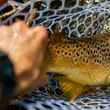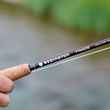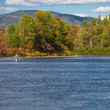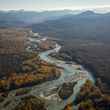Could introducing sensitive trout and char into a previously fishless lake in the Glacier National Park high country be key to preserving the fish as climate change continues to close its grip on cold-water fisheries in the northern Rockies?
The National Park Service thinks so, and it’s asking for public comment to do just that in Gunsight Lake, a small, high-mountain lake in the headwaters of the St. Mary River on the east side of the Continental Divide. The St. Mary is the only river in the United States east of the divide that is home to native bull trout.
But, before the bull trout and cutthroat trout could be introduced into the lake, a stocked population of non-native rainbow trout would have to be removed.
The lake, which was fishless before it was stocked with rainbows in the early 1900s, would then become a high-elevation refuge for the trout and char native to the drainage, but not to the lake. And, because the lake sits in a cirque above a series of impassible waterfalls, the likelihood of it being repopulated by non-native rainbows from downstream reaches of the river is very slim.
“Climate change presents additional threats that could compound the stressors faced by bull trout and westslope cutthroat trout in the St. Mary drainage,” reads a Park Service scoping document. “Changes in stream flow and warmer water temperatures stress native trout and favor non-native species. Given its high elevation, Gunsight Lake also has a high likelihood of sustaining the cold-water habitat necessary for westslope cutthroat and bull trout to persist in a changing climate.”
Bull trout are listed as threatened under the Endangered Species Act, and west slope cutthroat trout are a “species of concern” in Montana.
This wouldn’t be the first such project of its kind in the park. In 2019, the National Park Service worked with Montana Fish, Wildlife and Parks, the Glacier National Park Conservancy and the U.S. Fish and Wildlife Service to remove non-native Yellowstone cutthroat trout from Camas and Evangeline lakes in the Camas Creek drainage. To date, those removal and reintroduction projects have proven to be successful, which gives the Park Service hope for the Gunsight Lake project.
The non-native fish would be removed from Gunsight Lake with the aid of a piscicide — likely rotenone — and the effort could take some time. Similar Park Service efforts have occurred in rivers and streams throughout the national park system in the Rockies — efforts are still ongoing to introduce native greenback cutthroat trout in lakes in Colorado’s Rocky Mountain National Park, and work is ongoing to reintroduce west slope and Yellowstone cutthroat trout in their native watersheds in Yellowstone National Park.
Assuming the Park Service chooses to move forward with the project, it could start as soon as summer 2023. The piscicide would be applied to the lake when it’s at its lowest level in late summer. The introduction of the lake’s new trout and char likely wouldn’t happen until summer 2024. The Park Service notes that the project will require the use of helicopters to transport the equipment needed to kill the rainbows in the lake again to bring in the cutthroats and bull trout for introduction.
The genetically pure west slope cutthroat trout and bull trout that would be “translocated” to the lake would be sourced from secure populations within the St. Mary River drainage “or other drainages with similar evolutionary pressures,” the scoping document reads. It’s also likely, the Park Service says, that the effort will require that “donor fish” will be moved to a fish hatchery to ensure spawning success, at least at first.
The project is still in the planning phases — the public scoping process lasts through Oct. 26.































Comments